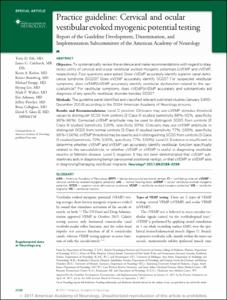Practice guideline: Cervical and ocular vestibular evoked myogenic potential testing: Report of the Guideline Development, Dissemination, and Implementation Subcommittee of the American Academy of Neurology
- Keimyung Author(s)
- Lee, Hyung
- Department
- Dept. of Neurology (신경과학)
- Journal Title
- Neurology
- Issued Date
- 2017
- Volume
- 89
- Issue
- 22
- Abstract
- OBJECTIVE:
To systematically review the evidence and make recommendations with regard to diagnostic utility of cervical and ocular vestibular evoked myogenic potentials (cVEMP and oVEMP, respectively). Four questions were asked: Does cVEMP accurately identify superior canal dehiscence syndrome (SCDS)? Does oVEMP accurately identify SCDS? For suspected vestibular symptoms, does cVEMP/oVEMP accurately identify vestibular dysfunction related to the saccule/utricle? For vestibular symptoms, does cVEMP/oVEMP accurately and substantively aid diagnosis of any specific vestibular disorder besides SCDS?
METHODS:
The guideline panel identified and classified relevant published studies (January 1980-December 2016) according to the 2004 American Academy of Neurology process.
RESULTS AND RECOMMENDATIONS:
Level C positive: Clinicians may use cVEMP stimulus threshold values to distinguish SCDS from controls (2 Class III studies) (sensitivity 86%-91%, specificity 90%-96%). Corrected cVEMP amplitude may be used to distinguish SCDS from controls (2 Class III studies) (sensitivity 100%, specificity 93%). Clinicians may use oVEMP amplitude to distinguish SCDS from normal controls (3 Class III studies) (sensitivity 77%-100%, specificity 98%-100%). oVEMP threshold may be used to aid in distinguishing SCDS from controls (3 Class III studies) (sensitivity 70%-100%, specificity 77%-100%). Level U: Evidence is insufficient to determine whether cVEMP and oVEMP can accurately identify vestibular function specifically related to the saccule/utricle, or whether cVEMP or oVEMP is useful in diagnosing vestibular neuritis or Ménière disease. Level C negative: It has not been demonstrated that cVEMP substantively aids in diagnosing benign paroxysmal positional vertigo, or that cVEMP or oVEMP aids in diagnosing/managing vestibular migraine.
- Keimyung Author(s)(Kor)
- 이형
- Publisher
- School of Medicine (의과대학)
- Citation
- Terry D. Fife et al. (2017). Practice guideline: Cervical and ocular vestibular evoked myogenic potential testing: Report of the Guideline Development, Dissemination, and Implementation Subcommittee of the American Academy of Neurology. Neurology, 89(22), 2288–2296. doi: 10.1212/WNL.0000000000004690
- Type
- Article
- ISSN
- 0028-3878
- Appears in Collections:
- 1. School of Medicine (의과대학) > Dept. of Neurology (신경과학)
- 파일 목록
-
-
Download
 oak-2018-0867.pdf
기타 데이터 / 661.98 kB / Adobe PDF
oak-2018-0867.pdf
기타 데이터 / 661.98 kB / Adobe PDF
-
Items in Repository are protected by copyright, with all rights reserved, unless otherwise indicated.